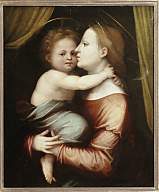 |
|
Madonna and child |
 |
|
Girolamo Savanarola 1498 |
Fra Bartolommeo (1472–1517), also known as Baccio della Porta, was a Florentine Renaissance painter and Dominican friar, active in Florence, Venice, and Rome. His work being largely religious in nature, his paintings Madonna and Child and Girolamo Savanarola exemplify the style of this largely influential Renaissance painter. The following is a short excerpt describing his life and the various ailments that lead to his death.
On Fra Bartolommeo from Lives of the Artists by Giorgio Vasari
He was loved in Florence for his ability; was an assiduous workman, quiet, good-natured, and God-fearing. He preferred a quiet life and avoided vicious pleasures, was very fond of sermons, and always sought the society of learned and staid people. It is rare when Nature creates a man of genius and a clever artist that she does not prove his worth. So it was with Baccio, who, as I shall say presently, fulfilled her desires to show the full extent of his excellence, and so spread abroad his name.
From working continually under a window, with the light from it beating on his back, he became completely paralyzed on that side of his body, and quite unable to move. Thereupon he was advised such being the orders of his physicians to go to the baths of San Filippo; where he stayed a long time, but became very little better thereby. He was a great lover of fruit, which pleased his palate mightily, although it was ruinous to his health. Wherefore one morning, having eaten many figs, there came upon him, in addition to his other infirmity, a very violent fever, which cut short the course of his life in four days, at the age of 48 . . .
GIORGIO VASARI (1511–1574) was an Italian painter, writer, historian, and architect. Although an artist of considerable repute, Vasari depends for immortality on his remarkable work, Vite de’ più eccell. pitori, scultori et archit (On the lives of the most eminent painters, sculptors, and architects), a work of stupendous industry. Its first edition appeared in 1550 in Florence. He is considered the ideological foundation of art-historical writing.
GEORGE DUNEA, MD, Editor-in-Chief
Highlighted in Frontispiece Winter 2012 – Volume 4, Issue 1, Highlighted Vignette Volume 13, Issue 4 – Fall 2021
Winter 2012 | Sections | Art Flashes

Leave a Reply